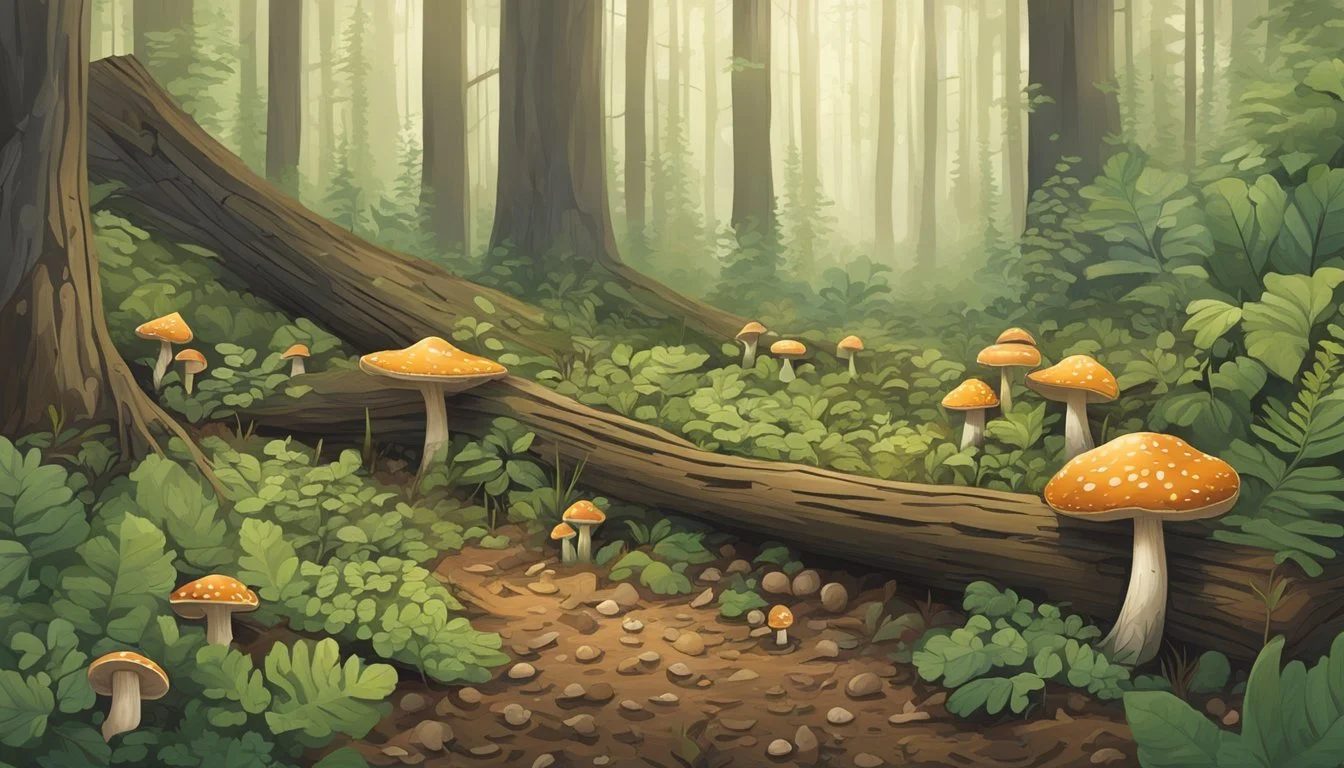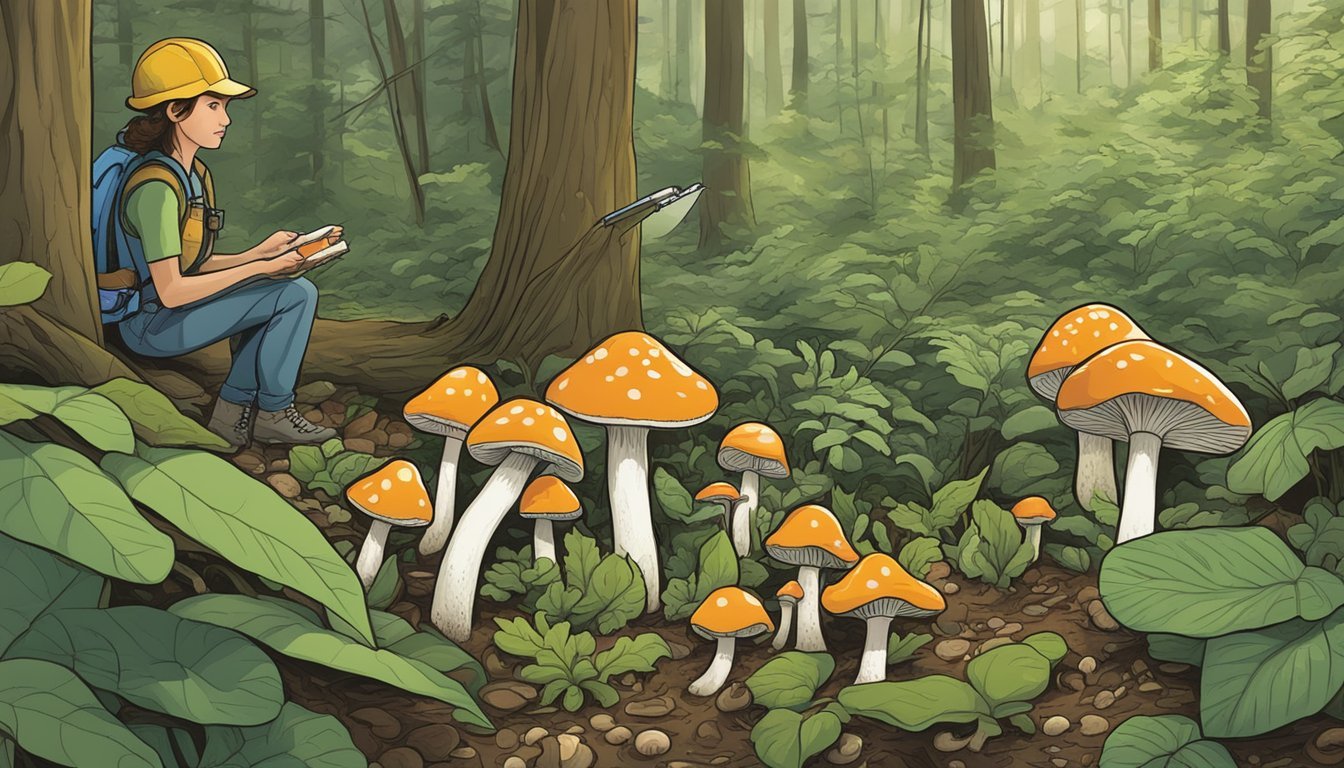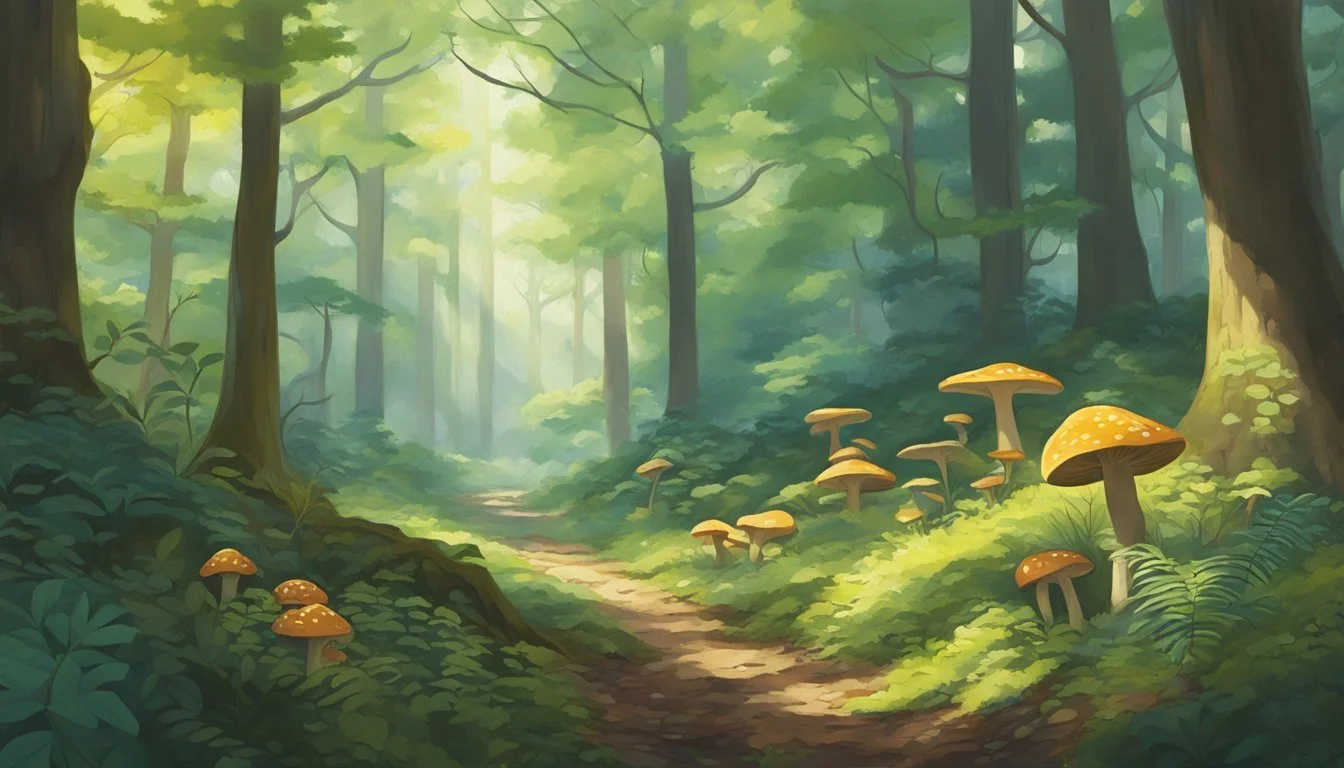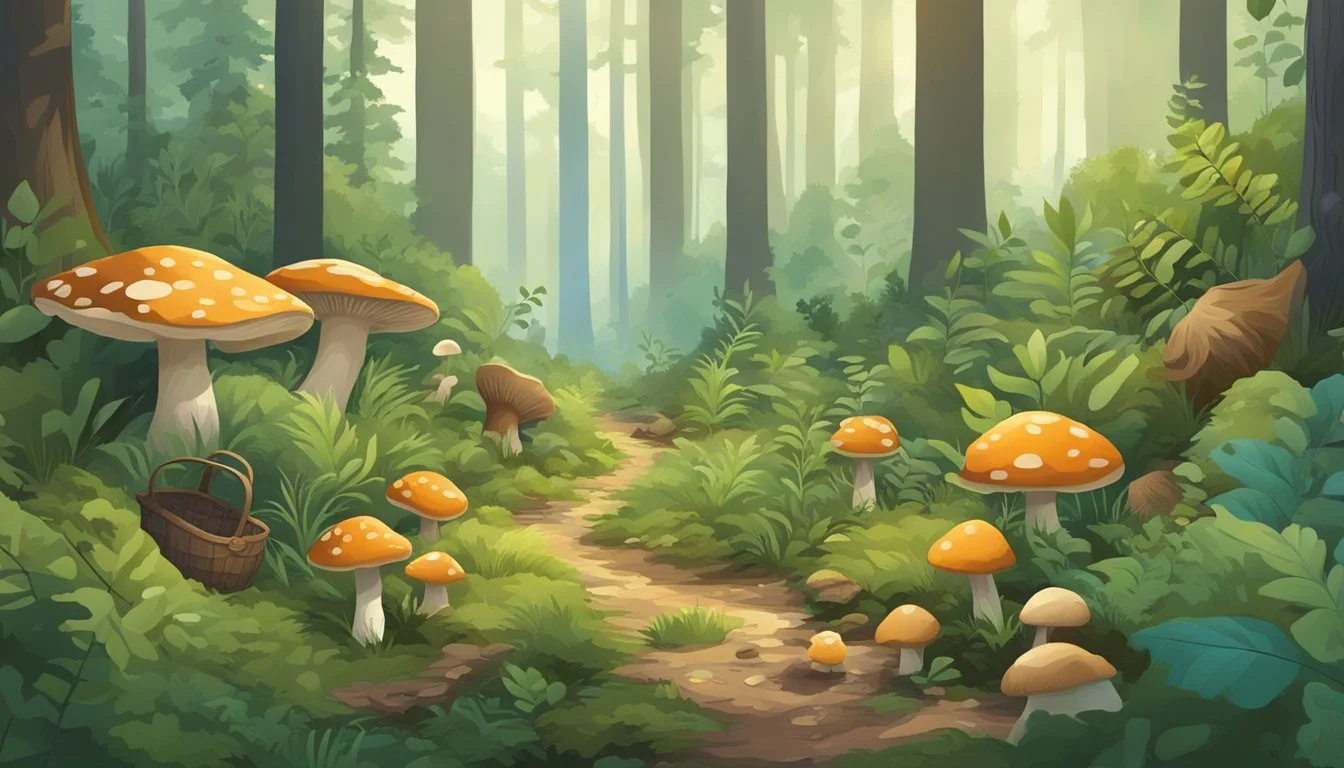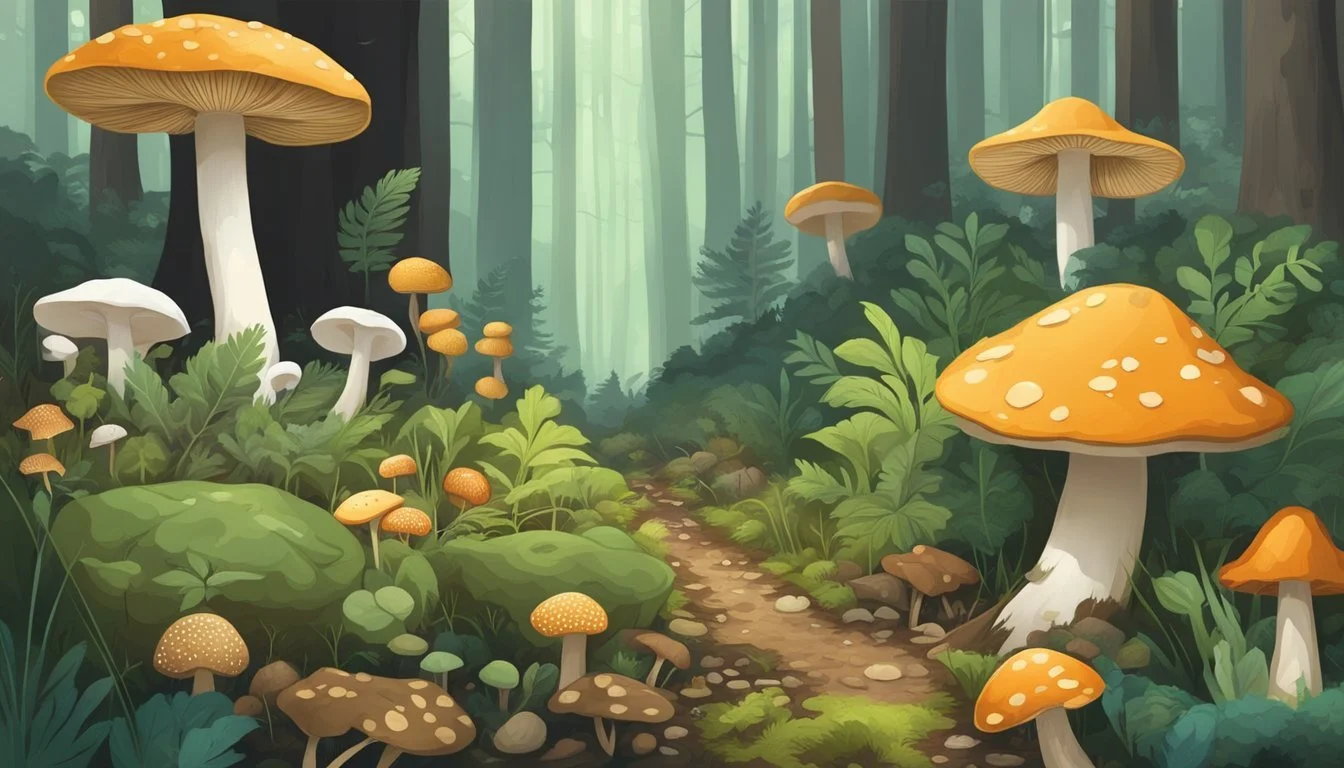Central Appalachia Mushroom Hunting
Tips and Best Practices
Mushroom hunting in Central Appalachia offers an enriching experience for both novices and seasoned foragers. The region's verdant forests, renowned for their biodiversity, host some truly remarkable fungi. Among these, Morel mushrooms stand out as a prized find, celebrated for their distinctive appearance and culinary value. Their honeycombed caps and rich, earthy flavors make them a sought-after delicacy during the spring season.
Exploring the lush landscapes of Central Appalachia, foragers are met with an abundance of edible and medicinal mushrooms. Guides like "Appalachian Mushrooms: A Field Guide" prove invaluable, offering insights into mushroom identification and safety. The thrill of discovery is palpable as hunters carefully scour the forest floor, each find a testament to the region's natural bounty.
Hunting for morels is a cherished tradition, reflecting the deep connection between Appalachians and their environment. Enthusiasts revel in the hunt, often sharing their experiences and tips within close-knit communities. Whether stepping into these woods for the first time or returning as a seasoned hunter, there is always a sense of adventure, anticipation, and respect for the untamed beauty of Central Appalachia's fungal treasures.
The Fundamentals of Mushroom Hunting in Central Appalachia
Central Appalachia offers a unique blend of rich biodiversity and cultural tradition, making it an excellent region for mushroom hunting. Hunters need to understand the region's ecology and the significance of foraging practices to fully appreciate their mushroom hunting experience.
Overview of Appalachia
The Appalachian Mountains stretch from New York to Alabama, covering a vast area known for its diverse ecosystems. Central Appalachia, particularly, boasts a wide range of habitats ideal for mushroom growth due to its temperate climate, abundant rainfall, and mixed hardwood forests.
Key Regions: Kentucky, West Virginia, Tennessee, and parts of Virginia and North Carolina.
These areas offer various mushrooms like morels, shiitakes, oysters, and lion's mane.
Mushrooms flourish in moist, shady environments often found in the dense understory of Appalachian forests. Common Types: Morels, chanterelles, and oyster mushrooms dominate spring and autumn foraging trips.
Importance of Mushroom Hunting
In Central Appalachia, mushroom hunting is more than a hobby—it is a cultural tradition. Locals have developed extensive knowledge of edible and medicinal mushrooms over generations, making foraging an integral part of their lifestyle.
Mushroom hunting fosters a connection to nature and sustains community bonds. Knowledge Transfer: Skills are often passed down through family and community, ensuring the survival of traditional foraging practices.
Mushrooms also contribute to regional cuisine, enhancing the variety and nutritional value of local dishes. Sustainable foraging practices help maintain ecological balance, ensuring that mushroom populations remain healthy and abundant.
Spring Mushroom Season in Appalachia
Spring in Appalachia brings a unique opportunity for mushroom enthusiasts to explore the diverse range of fungi that flourish during this season. Among the most prized finds are morels, complemented by other edible spring mushrooms. It is crucial to prioritize safety and ethical practices while foraging.
Morel Hunting
Morels belong to the genus Morchella and are highly sought after during the spring. Their distinctive honeycomb-like appearance makes them easy to identify for experienced hunters. These mushrooms typically thrive in moist, rich soils, often found near ash, elm, and apple trees.
Prime hunting locations include forested areas with abundant leaf litter and decaying wood. It is important to note that morels have a short fruiting period, usually emerging following a warm spell after spring rains.
Identifying Edible Spring Mushrooms
In addition to morels, the Appalachian spring offers various other edible mushrooms, such as chanterelles and oyster mushrooms. Chanterelles, with their vibrant orange hue and trumpet shape, are often found in mossy, hardwood forests. They emit a pleasant, apricot-like aroma.
Oyster mushrooms, which grow in shelf-like clusters on decaying logs, are identifiable by their white to light brown caps and gills running down the stem. Proper identification is essential to avoid toxic lookalikes.
Safety and Ethics of Spring Foraging
Foraging necessitates a strong adherence to safety to prevent the consumption of poisonous mushrooms. Beginners should consult expert guides and possibly join local mycological societies for verification. Tools such as knives, baskets, and field guides enhance the foraging experience.
Ethical foraging involves respecting the environment by not overharvesting and ensuring the sustainability of mushroom populations. Follow local regulations and only collect what is needed, leaving the habitat as undisturbed as possible.
Mushroom Species and Habitat
Central Appalachia offers a wide range of mushroom species growing in various unique habitats, from dense oak forests to decaying logs on the forest floor. These mushrooms play crucial roles in the local ecosystem, contributing to decay processes and nutrient cycling.
Typical Mushrooms in Appalachian Region
Several mushroom species are commonly found in Central Appalachia. Chanterelles (Cantharellus cibarius), known for their bright yellow-orange color, are often spotted near oak and beech trees. Morels (Morchella species), sought after for their distinctive honeycomb appearance and culinary value, typically emerge in spring near elms and ash trees. The Oyster Mushroom (Pleurotus ostreatus) grows on decaying logs, especially those of deciduous trees. Hen of the Woods (Grifola frondosa), recognized for its clustered, feather-like appearance, is commonly found at the base of oak trees.
Other notable mentions include the Fly Agaric (Amanita muscaria) with its iconic red cap and white spots and Lion’s Mane (Hericium erinaceus) which features cascading spines and is often found on hardwoods.
Habitat and Growth Patterns
The varied landscapes of Central Appalachia create diverse habitats for mushroom species. The dense forests, particularly those dominated by oak and beech trees, provide ideal conditions for species like chanterelles and hen of the woods. Morels prefer disturbed ground, often popping up after forest fires or logging activities.
Decaying logs and stumps are prime real estate for oyster mushrooms, which break down the wood fibers, enriching the soil. Mushrooms such as the lion's mane thrive on hardwoods in older, undisturbed forests. These growth patterns highlight the complex interaction between fungi and their environments.
Ecological Role of Mushrooms
Mushrooms are vital to forest ecosystems. As primary decomposers, they break down dead organic material, recycling nutrients back into the soil. This process supports new plant growth and maintains soil health.
Symbiotic relationships between fungi and tree roots, specifically mycorrhizal associations, enhance tree nutrient uptake. For instance, chanterelles are mycorrhizal with oaks and other hardwoods, forming beneficial partnerships.
Mushrooms also provide food for wildlife and contribute to the biodiversity of forest ecosystems. They support various species of insects, mammals, and other fungi, creating a dynamic web of ecological interactions.
Harvesting and Preservation Techniques
Careful harvesting and proper storage are crucial in maintaining the quality and longevity of foraged mushrooms. This section outlines efficient methods for collecting and preserving your finds to maximize their texture and flavor.
Harvesting Methods
Use a sharp knife or scissors to cut mushrooms at the base of the stem. This method prevents disturbing the mycelium, which is essential for future growth. Avoid pulling mushrooms directly from the ground as this can damage the underlying network.
Preparation: Equip yourself with breathable bags or baskets to carry mushrooms. This prevents moisture build-up and helps maintain mushrooms' texture. Appropriate footwear and protective clothing are also recommended due to the terrain and potential encounters with insects.
Field Practices: Minimize damage by handling mushrooms gently to avoid bruising or crushing. Pay attention to local guidelines and avoid harvesting in overharvested patches to sustain the ecosystem.
Storing and Preserving Mushrooms
Refrigeration: Store fresh mushrooms in a breathable bag in the refrigerator at temperatures between 36°F (2°C) and 46°F (8°C). This extends their shelf life while maintaining their quality. Avoid airtight containers as they can trap moisture and accelerate spoilage.
Drying: Drying mushrooms is an excellent preservation method. Slice them thinly and use a food dehydrator or oven at a low temperature. Once dried, store mushrooms in an airtight container in a cool, dark place, ensuring they remain usable for months.
Other Methods: If you wish to preserve mushrooms using other methods, consider sautéing them in butter and freezing the cooked mushrooms. This retains their texture and flavor, making them easy to incorporate into future meals.
Mushroom Identification and Safety
Accurately identifying mushrooms is crucial for Central Appalachia mushroom hunters. Knowing key features can help distinguish between edible varieties and their poisonous counterparts, ensuring a safe foraging experience.
Key Features for Identification
Identifying mushrooms involves examining several physical characteristics. Cap size and shape are significant markers; some mushrooms have flat, saucer-like caps, while others may be dome-shaped or conical. Color can also be a critical identifier but note that it may change with age or environmental conditions.
The gills, located on the underside of the cap, can vary in color, spacing, and attachment to the stem. Equally important is the stipe or stem, which varies in length, thickness, and texture. Mushroom hunters should also check for unique patterns on the cap or stem, like spots or streaks.
A spore print, obtained by placing the cap on a sheet of paper, reveals the spore color, which can be white, black, brown, or other colors. Paying attention to unique features, such as a distinct smell or the presence of a volva or ring, can further aid in identification and differentiate between edible and poisonous mushrooms.
Avoiding Poisonous Varieties
Safety in mushroom hunting involves strict avoidance of certain poisonous varieties. Amanita species, known for their deadly toxins, often have a bulbous base (volva) and a distinct ring around the stipe. Other toxic mushrooms, like those in the Galerina genus, can look very similar to edible varieties but typically have rusty brown spores and grow on wood.
One must never consume a mushroom unless it is positively identified as non-toxic by an experienced forager or verified guidebook. Particular caution should be taken with mushrooms exhibiting bright red or yellow colors, as these often signal toxicity. Using reputable sources and cross-referencing multiple features helps avoid dangerous mistakes.
Effective pattern recognition and understanding the unique characteristics of each mushroom increase both success and safety in central Appalachia mushroom hunting.
Cooking and Culinary Uses
Wild mushrooms from Central Appalachia offer a wide range of flavors and textures, making them versatile ingredients in various dishes. Techniques like sautéing and drying enhance their unique taste, while recipes vary from simple sautés to complex dishes.
Culinary Techniques for Appalachian Mushrooms
Proper cooking techniques bring out the best in Appalachian mushrooms. Sautéing is common; mushrooms are cooked in oil until they develop a rich color. It’s important to use a good-quality oil, such as olive oil, and add seasonings like salt early on.
Drying mushrooms is another useful method. This prolongs their shelf life and intensifies their flavors. Dried mushrooms can be rehydrated by soaking in warm water before use in soups or stews.
Recipes and Preparation Ideas
Central Appalachian mushrooms shine in various recipes. A classic approach is to prepare them by coating in flour and frying in butter, which adds a crispy texture. Another idea is to make a mushroom ragout, combining mushrooms with garlic, onions, and tomatoes for a rich, hearty dish.
Incorporating morel mushrooms in risottos or pasta dishes can elevate their flavor profile. They pair well with cream and white wine sauces, bringing a gourmet touch to an otherwise simple meal. Morels can also be stuffed with cheese and herbs for a delectable appetizer.
Using local ingredients, these mushrooms enrich both everyday dishes and special culinary experiences.
Cultural and Historical Significance
Mushroom hunting in Central Appalachia is deeply rooted in the cultural heritage and historical practices of the region. These traditions have been passed down through generations, significantly shaping the local way of life.
Mushroom Hunting in Appalachian Culture
Mushroom hunting, or foraging, is a significant aspect of Appalachian culture. It is a practice that connects the community with nature, providing both sustenance and recreation. Local foods such as morel mushrooms, known locally as "dry land fish," are highly prized. Families often venture into the Appalachian Mountains together to hunt for these edible treasures, fostering a strong sense of community and tradition.
The practice is also linked to the local cuisine, where foraged mushrooms are staples in many traditional dishes. Residents of the region often share recipes and preservation techniques, maintaining a rich culinary heritage. Mushroom hunters play an essential role in these cultural traditions by sharing their knowledge and experience with younger generations, ensuring that these practices continue to thrive.
Historical Perspectives on Mushroom Foraging
Historically, mushroom foraging in the Appalachian Mountains has strong roots in both Native American and early settler traditions. Native Americans taught early settlers how to identify and use various types of mushrooms for food and medicine. This knowledge was invaluable for survival in the region's often harsh and isolated environment.
Throughout history, edible and medicinal mushrooms have been essential for local foods and healthcare practices. They were a critical food source during lean times and were used in traditional medicinal treatments. The history of mushroom foraging also reflects the resourcefulness and adaptability of its people, who relied on the natural abundance of the region.
The historical significance of mushroom foraging is evident in the many stories and folklore that have been passed down. These tales often highlight the relationship between the people and the land, underscoring the importance of sustainability and respect for nature in local culture.
Mushroom Hunting Events and Communities
Mushroom hunting in Central Appalachia is supported by a variety of in-person events and thriving online communities that offer resources and knowledge sharing for enthusiasts.
Local Hunting Events
Central Appalachia hosts several notable mushroom hunting events throughout the year. The Mountain Mushroom Festival in Kentucky is a key event celebrating the morel mushroom and Appalachian culture. It features not only foraging activities but also arts, crafts, and local heritage.
Another event to consider is the educational program on hunting and identifying edible mushrooms in North Carolina. It provides virtual show-and-tell demonstrations and expert talks.
Participants in these events gain hands-on Experience, and they can often reach out for assistance from experienced hunters via event websites.
Online Communities and Resources
Beyond local events, mushroom enthusiasts benefit from a vast array of online communities and resources. Websites like the Mycelium Society provide detailed information on foraging and identifying mushrooms such as Lion’s Mane, which is noted for its medicinal properties.
Online forums and social media groups also offer platforms for beginners and experts alike to share their Experiences, tips, and photos. These communities create a decentralized network of support and knowledge sharing, making it easier for new hunters to get started and for experienced hunters to refine their skills.
Conservation and Sustainable Practices
Mushroom hunting in Central Appalachia requires thoughtful approaches to maintain ecological balance and ensure future generations can enjoy these rich resources. It's crucial to understand the impact of foraging practices on local ecosystems and adopt sustainable methods.
Impact on Local Ecosystems
Foraging mushrooms can significantly affect Central Appalachia's diverse ecosystems. Mushrooms play a pivotal role in nutrient cycling, breaking down organic matter and contributing to soil health. Disturbing these fungi can disrupt this process and negatively impact plant growth.
Removal of large quantities of mushrooms can reduce the food sources for local wildlife, creating potential imbalances. Moreover, some species of mushrooms are mycorrhizal, forming essential symbiotic relationships with trees and other plants. Proper foraging techniques help preserve these valuable ecological partnerships, supporting overall forest health.
Sustainable Mushroom Foraging
Adopting sustainable foraging practices ensures the long-term health of mushroom populations and their environments. Harvest only what you need, leaving some mushrooms behind to spore. This practice helps maintain the fungi population.
Avoid damaging the mycelium network, the underground structure of fungi vital for growth. Using tools like knives can help minimize this impact. Additionally, foragers should familiarize themselves with local conservation regulations and permits, supporting broader efforts to protect these areas.
Education on species-specific sustainability is also key. Not all mushrooms have the same ecological role or growth rate. Focusing on abundant and fast-growing species, while avoiding vulnerable or rare ones, aids in responsible foraging.
Legal Considerations and Permissions
Understanding the legal landscape and securing permissions are crucial aspects of mushroom hunting in Central Appalachia. Knowledge of state regulations, local laws, and proper landowner permissions ensures a responsible and enjoyable foraging experience.
Regulations and Laws in Appalachia
Mushroom hunting laws vary across the Appalachian states. Most public lands, including state parks and forests, allow mushroom foraging, albeit with specific guidelines.
In Indiana, hunting mushrooms is legal on state-owned lands, though nature preserves within these areas may have restrictions.
West Virginia and Kentucky also permit mushroom hunting on public lands but often require adherence to rules that protect the environment.
Always check if a permit is necessary. For instance, some regions offer daily or seasonal permits with rules on the quantity and types of mushrooms that can be harvested. Protecting the habitat is essential, which often means leaving behind a portion of the fungi to ensure natural regrowth.
Landowner Permissions
When mushroom hunting on private property, securing landowner permission is non-negotiable. Verbal consent may be sufficient, but written permission can protect against potential misunderstandings.
Respect for private property is paramount. Before entering, hunters should clearly explain their intentions and offer assurances such as leaving no trace and not disturbing the land. Establishing a good rapport with landowners can lead to ongoing access and shared benefits.
Ethically, foragers must guarantee they do not overharvest. The common practice is to pick no more than two-thirds of the mushrooms in a given area, allowing the rest to continue their lifecycle. Respect and responsible behavior uphold foraging ethics and foster trust with property owners.



